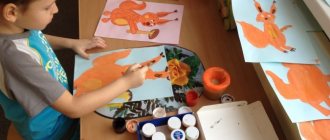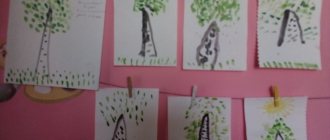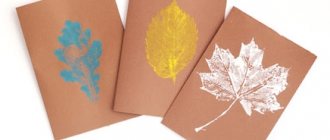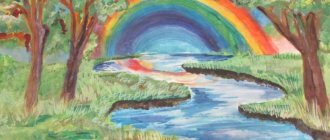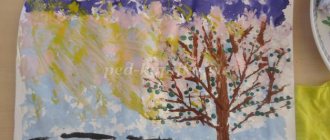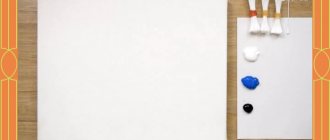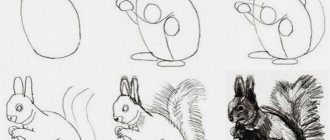Drawing lesson in the middle group of kindergarten “Who built the new house?”
Title: Drawing lesson in the middle group of kindergarten “Who built the new house?” Nomination: Kindergarten, Notes for an art class, notes for a drawing class in the middle group Author: Artemenko Marina Vladimirovna
Integrated lesson: Getting to know your surroundings. Who built the new house? Drawing. My dream house.
Goal: To develop children’s knowledge about the work of builders and workers of various specialties; consolidate the ability to work according to the labor process model; develop respect for the work of adults.
Continue learning to draw by idea; strengthen the ability to work with paint and brush; develop imagination and fantasy.
Materials: models of the labor process, houses made of straw and ice, cubes, A4 paper, paints, brushes, a simple pencil.
Vocabulary: crane operator, painter, mason, carpenter, trowel.
Progress of the lesson:
A guest (the gnome Vasya) comes to class
- Guys, look who came to visit us?
- Hello, Vasya. Why are you so sad?
Vasya: - It's a shame. My older brothers all think that I’m small and don’t know how to do anything. I really want to prove to them that I have already grown up. So I decided to build a house, ours is very small and old. But I don’t know how to build a house.
— Guys, you and I have already helped Vasya a lot (we drew a portrait, wrote his name, told him about the cat), so he turned to us for help. Let's help him!
What kind of house would you like to build?
Vasya: - I don’t know.
- Guys, Vasya has 6 more brothers, and if more guests come, what kind of house do you think they will need?
(large, spacious, many rooms)
I display the model on the board.
- Could it be like this? What is it like? (Tall, two-story, large)
Fine. What will we build a house from?
Model (a heap of straw, ice bricks, an ordinary brick, a log, a cube).
Vasya suggests building a house out of straw.
— Guys, can you build a house out of straw? Why?
— Who has already tried to build such a house? What came of it? I invite the children to choose materials for construction.
Vasya - Oh, I wanted bricks like these, they are transparent and light.
— Who will explain to Vasya why you didn’t choose ice bricks?
Children: The house will be cold, slippery, but in the spring the sun will warm it up and the house will melt.
- Guys, in which fairy tale have we already seen an ice house? (In the fairy tale “Zayushkina’s hut”)
- Don’t you need a cube? Why?
— Is it possible to build a house from cubes?
Vasya claims that it is possible, and suggests building a wall from cubes.
Together with Vasya we are building a wall.
.Anara, try to see if the wall is strong? (No, it’s easy to break. The wind will blow through the cracks, rain will get in, the cubes will not stand strong).
This means that cubes won't work either.
So we chose brick and log. What will we make from bricks? (House).
Why a log? (Doors, floor).
Here you go. The material has been chosen, who will carry the bricks and logs to the construction site? (Chauffeur).
Physical exercise “We are drivers”
Let's go up to the car, check the wheels (imitate how the driver taps the wheel with his foot), pump up the wheels (squats), and drive off (imitate the movement of the car, turn the steering wheel). We have arrived. (Children sit down).
Drawing lesson in the middle group of kindergarten “Who built the new house?”
— We brought the material. What is needed so that the bricks stick together and the wind does not blow through the cracks? (Solution). A picture is displayed (a bucket with a solution, a trowel).
- Right. And the mortar is applied to the bricks with a special spatula called a “trowel.”
- Do you know the name of the person who folds and builds the walls of a house?
- That's right, this is a bricklayer, (a picture of a bricklayer is displayed)
—Who will need these tools? (picture of a hammer and nail).
- Why does a carpenter need them?
— Guys, we will build a tall house. Who will help the mason lift the bricks up?
—Who operates the crane? Crane operator.
— Tell me, were all the tools useful to us? Why do we need a brush?
— Who paints the walls, frames, doors? Painter
— Bricklayer, carpenter, crane operator, painter. What are all these people doing0) building a new house).
- How can we call all these people in one word? Builders.
- That's right, all these people are builders. They will help us and Vasya build a new house. Here it is (a drawing of a house is displayed).
There are so many bright windows in it - I can’t count them,
And the roof is so high
What birds can't get.
The house has ten floors,
There are thousands of people in the house.
- Guys, what house is it? Light, beautiful, tall, large, brick, red, multi-colored, gray, etc.
- What was Vasya like and what did he become?) Sad, sorrowful, boring, cheerful, funny, joyful, kind.
- Do you think the house can be sad? Funny? Kind? When? Why?
- Children, do you want to dream up?
- I suggest you draw a house IN WHICH YOU WOULD LIKE TO LIVE.
Independent work of children.
Title: Drawing lesson in the middle group of kindergarten “Who built the new house?” Nomination: Kindergarten, notes of a drawing lesson in the middle group, notes of a lesson in fine art, art activities, middle group Author: Artemenko Marina Vladimirovna Position: teacher of the highest qualification category Place of work: State Public Enterprise "Nursery-Garden "Solnyshko" Location: Petropavlovsk, North Kazakhstan region, Republic of Kazakhstan
Date modified: 07/16/2017
GCD for children of the middle group of preschool educational institution “Visiting grandma in the village”
- October 14, 2016
GCD for children in the middle group of kindergarten.
Can be used as a final educational activity on the topic “Pets”. Integration of educational areas : “Communication”, “Artistic creativity” (theater activities), “Cognition”, “Socialization”.
Types of children's activities: playful, productive, communicative, cognitive and research.
GCD tasks:
1. To enhance children’s knowledge about domestic animals, where they live, what they eat, and the characteristic features of animals.
2. Teach preschoolers to give generalizing concepts.
3. Teach children to recognize animals by description.
4. Develop fine motor skills of the hands.
5. Develop children's creative abilities.
6. Develop thinking, memory, attention, imagination of preschoolers; educate them to have a tolerant attitude towards animals.
The tasks of the NGO “Poznanie”: to activate the names of domestic animals and their cubs, to give an idea of the benefits that animals bring.
The objectives of the NGO “Communication”: to learn to use the correct forms of the names of young domestic animals in speech, to develop dialogical speech: to learn to participate in a conversation, to answer questions, to learn to guess riddles.
Objectives of the NGO “Artistic Creativity” (theater activities): teach how to work with the mitten theater.
Vocabulary work: Kitten, puppy, foal, piglet, kid.
Planned results : show interest in new information that they receive during communication and game moments, are able to maintain a conversation, draw conclusions, perform movements depicting animals, find animals, food for them, work with the vareshkov theater.
Material: bus, steering wheel, house, grandmother, animal silhouettes, plate, bone, hay, cabbage, oats, steering wheel, mitten theater. You can buy children's clothes for classes in kindergarten and for walking outside here.
GCD move
1 part.
Children stand next to the teacher.
Educator: Guys. Do you like to travel? Today we are going to the village to visit our grandmother. Grandmother lives far away. How can you get to it? (Children's answers). We leave by bus.
Educator: To make our ride more fun, we will ride to a cheerful song, to which we will perform movements. And choose a driver with a magic arrow
(The guys stand in a circle, pretend that they are riding a bus and perform movements to the music).
Part 2.
Educator: Here we are. Look how beautiful the village is. Here is grandma's house and garden. And we will go along the paths to grandma’s house.
They ran along the path and got to grandma’s house!
(They ran up to grandma’s house.)
Educator: Here we are, but the door is closed. You have to knock for grandma to open the door.
(Children knock, say out loud “knock”, “knock”, “knock”.).
The teacher puts on the granny toy.
Grandmother: Hello, my dear guys.
You drove, you drove, you arrived in the village! Hello guys! My golden grandchildren! I'm so glad to see you!
Grandmother: But I need your help. My animals hid. Please help me find them and feed them. Can you help? (Children's answer).
Guys, listen to the riddles :
Who gives us a paw and leads us into the yard for a walk, diligently guards the house, often wags his tail.
Who is this? That's right, it's a dog. Let's find a dog, how does it bark? The dog barks sadly, probably wants to eat. What does a dog like to eat? (Children's answer).
Grandma: Look, I prepared food for the animals. Let's choose food for the dog (children come to the table and choose, find bones). Let's feed the dog (children take bones and give them to the dog). Why do people get dogs? (For protection, for hunting, they help shepherds herd domestic animals).
2. Next riddle : Tail with a hook, nose with a snout. Who is this? (Pig). Let's find the pig. Guys, go to the table with food, look and think about what we can feed the pig (children’s assumptions).
Grandmother: The pig's favorite treat is apples. Guys, take the apples and feed the animal. Let's show you how a pig grunts!
3. Next riddle : Guys, listen carefully to who is screaming and jumping like that (the soundtrack of horse sounds is turned on). (Children's answers)
Grandmother: Yes, this is one of the most beautiful and strong animals... What does a horse eat? (Grass). And the horse also loves to eat oats. See what it looks like, you can touch it. Let's find oats and grass on the table and feed the horse.
4. Riddle : Guys, what animal do you think we can feed with cabbage? (Children's answers). That's right, it's a goat.
Let's play the game “The horned goat is coming...”
Part 3.
Grandmother: Now let’s play the game “In the Meadow.”
We went out and went out into the meadow to see who was grazing there. Maybe horses?
Children walk through the group to music and show horses.
“In the meadow, in the meadow. KOs are grazing in the meadow...” Who can graze? Horses? No, not horses!
“In the meadow. In the meadow. KOs are grazing in the meadow...” Cows?
Grandma: That's right, cows! This is the largest domestic animal. What does a cow give to a person? (Milk). Milk is very healthy, and who loves milk? Well done.
Part 4
Grandmother: Guys, who else lives with grandma? Soft paws, and scratches in the paws (cat).
Grandma: Guys, let's play. The cat has kids - who are they? (Children's answer). And the mother cat teaches her kittens. We choose a cat.
Outdoor game “Cat”: a cat is chosen and sits in the middle of the circle, the children also sit on their knees and show what the cat is showing.
Grandma: Guys. And the animals became sad. It turns out that their cubs ran away. And mothers worry about them. What to do? (Let's find the cubs).
Grandmother: Let's help, guys, and bring the cubs to their mothers.
Game “Find Mom” (the teacher invites the children to choose any animal glove themselves). Guys, I remind you that we move carefully, without touching each other.
Animal moms:
- Pig
- Goat
- Dog
- Cat
- Horse.
The guys walk around the hall to the music; at the signal, the guys must run up to the silhouette of the animal in accordance with the glove.
Grandmother: Well, we visited grandma, and now it’s time to go back to kindergarten. Did you enjoy the trip? Thank you, grandchildren, you helped me a lot. And here are the hotels (gingerbread) for you!
The children say goodbye to their grandmother. They get on the bus.
Part 5
Educator: Guys, you have already said that you liked the trip. Where else would you go on a trip? As a keepsake of our journey, I give you these illustrations, decorate them yourself.
(The children are given silhouettes of pets, which they can decorate in their free time. Children name the silhouettes of the animals.)
Author: Oksana Viktorovna Kosova, teacher at MDOU Kindergarten No. 6, Pugachev, Saratov region.
